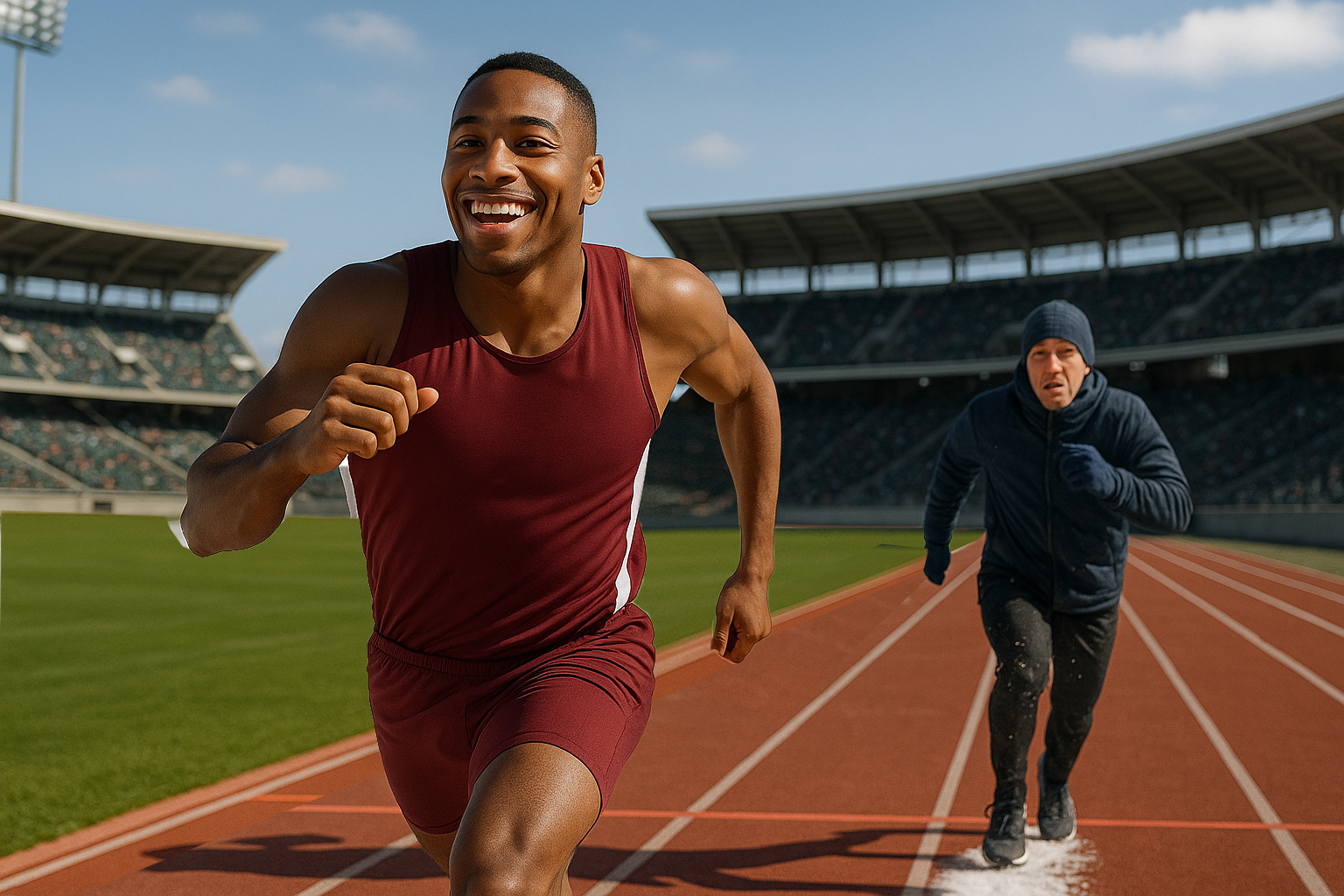By Cameron Steeels
So, you wanna run fast like lightning-bolt, blink-and-you’ll-miss-it fast. Whether you’re grinding on the track to go pro, shave a second off your PB (personal best), or just leave your friends in the dust at a local meet, one thing’s clear: training environment matters. Big time.
But here’s the question that’s sparked more trackside debates than pre-race rituals:
Is it better for sprinters to train in hot-weather cities (like Miami, L.A., or Nairobi) or in cooler northern climates (think London, Berlin, or Toronto)?
Let’s break it down.
☀️ THE HEAT ADVANTAGE
1. Warm Muscles = Less Risk of Injury
Sprinters are all about explosive power. But that power needs to come from warm, flexible muscles. Ever tried to stretch a rubber band straight out of the freezer? Snap. That’s kind of what cold-weather sprinting can feel like if your body isn’t prepped.
In hot weather:
- Your muscles stay warm more naturally.
- Blood flows better, helping deliver oxygen and nutrients where you need them.
- You’re less likely to pull a hamstring or strain a quad during that all-out 100m burst.
In short: heat is like a built-in warmup. It keeps you ready to fire without as much prep. That’s a win.
2. Longer Outdoor Seasons
Sprinters are creatures of habit—and they love the open track. Training outside is essential for:
- Working on real track mechanics.
- Practicing starts, turns, and sprints with full room to move.
- Getting those Vitamin D boosts (mental health counts too).
In warmer cities, sprinters can train outdoors year-round without worrying about snow, sleet, or 5 layers of compression gear. This gives athletes more consistent volume and time on track.
3. Heat Boosts Metabolic Conditioning
Training in hot climates forces your body to work harder to cool itself down. Sounds like a drawback? Actually, it’s a secret weapon:
- Your cardiovascular system becomes more efficient.
- You sweat sooner, helping regulate temperature better during meets.
- It trains your mental toughness—you get used to discomfort.
Think of it like wearing ankle weights during practice. Train harder, race easier.
❄️ THE COLD-WEATHER CHALLENGE (BUT ALSO PERKS)
Okay, so heat’s looking pretty sweet. But training in cooler climates isn’t all bad—especially if you know how to work it right.
1. Controlled Environments = Precision Training
Cooler cities often rely on indoor tracks during fall and winter. These setups can actually offer:
- Climate control, so your training’s not interrupted by storms or sweltering humidity.
- Consistent surfaces, which means better tracking of your times and progress.
- Specialized facilities, like cryotherapy, ice baths, or resistance sleds—tools that elite sprinters love.
Athletes like Canadian sprinter Andre De Grasse train in Toronto in winter, then migrate south for the season. It’s a balance build power indoors, explode outdoors.
2. Cooler Temps Help With Recovery
Let’s talk recovery. After sprinting, your muscles are inflamed, broken down, and screaming for chill time (literally).
In cooler places:
- Post-run cool-downs are more effective.
- You’re more likely to get better sleep (our bodies rest better in cool air).
- Muscle soreness can subside faster, especially when paired with cold-water therapy.
That’s a big deal. Because speed gains don’t come from the grind alone—they come from rest + repair.
💥 PERFORMANCE COMPARISON: WHO HAS THE EDGE?
Let’s look at actual outcomes. Do sprinters from hot places always win?
Top Hot-Weather Sprinter Hubs:
- Jamaica 🇯🇲 (Usain Bolt, Shelly-Ann Fraser-Pryce)
- Florida, USA 🇺🇸 (Noah Lyles, Sha’Carri Richardson)
- Kenya 🇰🇪 (though more dominant in distance, they have emerging sprinters)
- Texas, USA 🇺🇸 (rising youth sprint empire)
Top Cool-Weather Sprinter Hubs:
- United Kingdom 🇬🇧 (Dina Asher-Smith, Zharnel Hughes)
- Canada 🇨🇦 (Andre De Grasse)
- Germany 🇩🇪 (Julian Reus)
Here’s the twist: many northern athletes actually relocate or train part-time in warmer climates. It’s super common for European and Canadian sprinters to spend winter months in Florida, California, or South Africa to get that heat advantage.
Why? Because:
- You can train harder and longer without tightness.
- You stay healthier (fewer colds + fewer injuries).
- You get a mental edge when it’s time to race.
So the real winner? Hybrid training—cool base, hot boost.
🌡️ SCIENCE CHECK: HOW HEAT AFFECTS SPRINT PERFORMANCE
You might’ve heard that running in the heat makes you slower. That’s true—for distance runners. But for sprinters?
Research actually shows:
- Hot temperatures (around 25–30°C or 77–86°F) increase muscle power output.
- Reaction times may slightly improve in heat due to faster nerve conduction.
- The elasticity of tendons and muscles is higher, making you feel more “spring-loaded.”
That means your stride is more explosive, your turnover rate increases, and you might even shave tenths of a second off your time—which, in sprinting, is everything.
BUT… if it gets too hot (above 35°C or 95°F), dehydration kicks in fast, your coordination can suffer, and your body starts fighting against you. That’s why top sprinters monitor hydration, wear light gear, and train smart in extreme heat.
🇺🇸 WHY TEXAS & FLORIDA HAVE THE FASTEST YOUNG SPRINTERS IN THE WORLD
Now, let’s talk about the U.S. sprint factories: Texas and Florida.
These two states are dominating youth track. Why? It’s a mix of climate, culture, competition, and coaching.
🔥 1. Year-Round Sprint Weather
Both Texas and Florida have mild winters and blazing summers, so their athletes get:
- More outdoor track sessions
- Less time off for weather delays
- Longer competition seasons
This allows young sprinters to hit more reps, build better mechanics, and get faster—faster.
🧬 2. Genetics + Demographics
Let’s keep it real—diverse, athletic talent pools matter. These states have:
- Huge Black, Afro-Caribbean, and Latino communities with deep athletic traditions.
- Many young athletes who come from football or basketball, where sprinting and explosiveness are key.
Texas especially overlaps with football culture, where 40-yard dash speed is king, which builds sprint talent early—even before kids pick track.
🏟️ 3. Insane High School Competition
The level of youth track competition in these states is next-level:
- Texas UIL and Florida FHSAA championships look like mini-Olympics.
- Kids are dropping sub-10.3 100m and sub-21 200m—in high school.
- The depth of talent means athletes are constantly pushed by each other.
It’s like training in a pressure cooker. You either level up—or get left behind.
👟 4. Elite Coaches + Clubs
Florida and Texas are packed with world-class track coaches, youth clubs, and former Olympians who now train the next generation. These athletes get access to:
- Pro-level sprint drills
- Speed mechanics from Day 1
- Early exposure to nutrition, recovery, and mindset training
This is why names like Matthew Boling, Erriyon Knighton, Jaylen Slade, and others blew up before they even graduated high school.
⚖️ THE VERDICT: HOT OR COLD?
Let’s put it side by side:
| 🌞 Hot-Weather Training | ❄️ Cool-Weather Training |
|---|---|
| Muscles stay loose, reducing injury risk | Better recovery in cooler air |
| Year-round outdoor training possible | Precise, controlled indoor sessions |
| Boosts cardiovascular efficiency | Lower humidity = easier breathing |
| More explosive power in optimal temps | Easier access to certain recovery tech |
| May lead to overheating or fatigue | Muscles need longer warmups |
| Mental edge from “heat toughness” | Mental edge from battling through cold |

